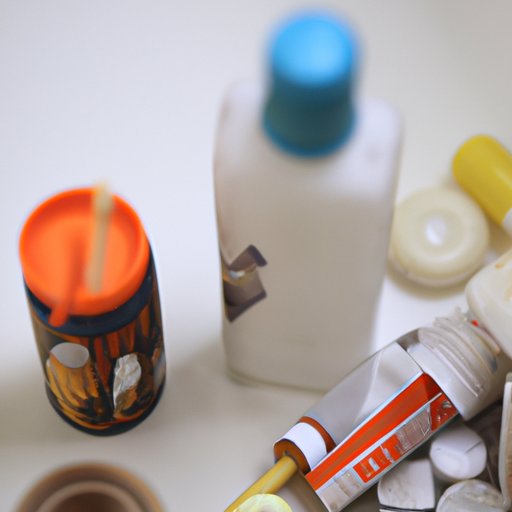Introduction
A dry socket is a common complication that can occur after having a tooth pulled. It occurs when the blood clot that naturally forms in the socket after a tooth extraction fails to develop or is lost. Dry socket is also known as alveolar osteitis.
The symptoms of dry socket include severe pain in the affected area, bad breath, and a foul taste in the mouth. The pain may radiate to other parts of the face, neck, and ear. There may also be visible bone in the socket.
This article provides an overview of dry socket and offers step-by-step instructions on how to take care of it at home. It covers the importance of cleaning the area around the dry socket, using antiseptics, managing pain, and avoiding certain activities.
Cleaning the Area Around the Dry Socket
It is important to clean the area around the dry socket to help promote healing. Use a soft toothbrush to gently brush the area, taking care not to irritate the socket. Avoid vigorous brushing as this can cause further damage.
When brushing, use gentle circular motions to remove any food particles or debris that may have accumulated. Do not use a toothpick or other sharp instrument to clean the area as this could cause further damage.
Using Antiseptics
Antiseptics can help reduce the risk of infection and speed up the healing process. Over-the-counter antiseptic rinses or gels can be used to clean the area around the dry socket. Follow the instructions on the product’s label for best results.
It is important to apply the antiseptic twice per day, once in the morning and again in the evening. This will help reduce the risk of infection and aid in the healing process.
Pain Management
Dry socket can be very painful and it is important to manage the pain to help promote healing. Over-the-counter pain relievers such as ibuprofen, aspirin, or acetaminophen can help to alleviate the pain. It is important to follow the instructions on the product’s label for best results.
In addition to over-the-counter pain relievers, a cold compress can also help to reduce the pain. Place a cold pack or ice wrapped in a towel against the affected area for 15 minutes several times per day. This will help to reduce inflammation and alleviate the pain.
Avoiding Certain Activities
Certain activities should be avoided while recovering from dry socket. Smoking can delay healing and increase the risk of infection, so it is best to avoid smoking during the recovery period. Drinking alcohol can also interfere with the healing process, so it is best to avoid drinking alcohol until the dry socket has healed.
Eating hard foods should also be avoided as this can disrupt the healing process and cause further irritation to the affected area. Soft foods such as mashed potatoes, applesauce, and yogurt are best.
Conclusion
Dry socket is a common complication that can occur after having a tooth pulled. It is important to take steps to promote healing and reduce the risk of infection. This includes cleaning the area around the dry socket, using antiseptics, managing pain, and avoiding certain activities. If the symptoms of dry socket persist, it is important to contact a doctor for further evaluation and treatment.
(Note: Is this article not meeting your expectations? Do you have knowledge or insights to share? Unlock new opportunities and expand your reach by joining our authors team. Click Registration to join us and share your expertise with our readers.)
